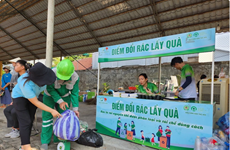Tam Giang - Cau Hai lagoon project protects wildlife
A community-based programme has been carried out to successfully protect
the fish and animal life in 10 zones totalling 307 hectares of Tam
Giang - Cau Hai lagoon in central Thua Thien-Hue province.
A community-based programme has been carried out to successfully protect
the fish and animal life in 10 zones totalling 307 hectares of Tam
Giang - Cau Hai lagoon in central Thua Thien-Hue province.
The zones include the 17.7-ha Con Cat zone in the province's Phong Dien district, 23.6-ha Con Chim zone in Phu Vang district, the 40-ha Vung Me zone in Quang Dien district, the 15-ha Con Sao in Huong Tra district, and the 14-ha Gianh Lang zone in Phu Loc district.
According to the local authority, prohibited activities set under the programme started in 2009 include illegal exploitation of the area, illegal fishing, unauthorised construction and releasing non-native animals into the zones.
To enforce the regulations, the authority erected sign poles and replanted aqua flora species that are endemic to the lagoons, in an attempt to reduce pollution and return the area to its natural state.
Also, eight professional fishing teams have been set up, with participation of local residents, for the protection of these zones.
In 2003, the teams carried out more than 400 inspections, preventing much illegal fishing in the protected zones.
Further, the zoning has helped protect the breeding environment, as well as ensure no harvesting of fish eggs or young fish occurs, resulting in a higher population of sea life and higher reproduction levels of fish in the zones.
Additionally, local residents have been educated about protection of the lagoons, as they have learned that the recovery of seafood in the zones benefits them economically. Meanwhile, environmental pollution in the zones has been sharply reduced.
The department is preparing the formation of seven other zones in the coming years in an attempt to increase the number of protected lagoons.
The Tam Giang - Cau Hai lagoon system is the largest of its kind in Southeast Asia, covering as much as 22,000ha, and ranging in five districts of Phong Dien, Quang Dien, Huong Tra, Phu Vang, and Phu Loc of Thua Thien-Hue province.
It is home to 921 water species, including rare fish and plants. It also supplies food and shelter to 73 migrating bird species.-VNA
The zones include the 17.7-ha Con Cat zone in the province's Phong Dien district, 23.6-ha Con Chim zone in Phu Vang district, the 40-ha Vung Me zone in Quang Dien district, the 15-ha Con Sao in Huong Tra district, and the 14-ha Gianh Lang zone in Phu Loc district.
According to the local authority, prohibited activities set under the programme started in 2009 include illegal exploitation of the area, illegal fishing, unauthorised construction and releasing non-native animals into the zones.
To enforce the regulations, the authority erected sign poles and replanted aqua flora species that are endemic to the lagoons, in an attempt to reduce pollution and return the area to its natural state.
Also, eight professional fishing teams have been set up, with participation of local residents, for the protection of these zones.
In 2003, the teams carried out more than 400 inspections, preventing much illegal fishing in the protected zones.
Further, the zoning has helped protect the breeding environment, as well as ensure no harvesting of fish eggs or young fish occurs, resulting in a higher population of sea life and higher reproduction levels of fish in the zones.
Additionally, local residents have been educated about protection of the lagoons, as they have learned that the recovery of seafood in the zones benefits them economically. Meanwhile, environmental pollution in the zones has been sharply reduced.
The department is preparing the formation of seven other zones in the coming years in an attempt to increase the number of protected lagoons.
The Tam Giang - Cau Hai lagoon system is the largest of its kind in Southeast Asia, covering as much as 22,000ha, and ranging in five districts of Phong Dien, Quang Dien, Huong Tra, Phu Vang, and Phu Loc of Thua Thien-Hue province.
It is home to 921 water species, including rare fish and plants. It also supplies food and shelter to 73 migrating bird species.-VNA













